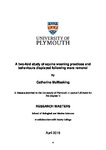A two-fold study of equine weaning practices and behaviours displayed following mare removal
| dc.contributor.supervisor | Walker, Anna | |
| dc.contributor.author | McMeeking, Catherine | |
| dc.contributor.other | School of Biological and Marine Sciences | en_US |
| dc.date.accessioned | 2019-06-11T15:47:49Z | |
| dc.date.issued | 2019 | |
| dc.date.issued | 2019 | |
| dc.identifier | 10103991 | en_US |
| dc.identifier.uri | http://hdl.handle.net/10026.1/14303 | |
| dc.description.abstract |
The behavioural effects on the foal and dam during weaning in horses are well documented and it is commonly agreed that both are likely to suffer from stress at this time. Many different weaning methods are employed worldwide, with no indication of the least stress inducing. This study has two aims. First, to document frequency of weaning method, type of breeder, foal age at the time of mare removal and reason for use of weaning method. Second, to compare behaviours following abrupt and gradual weaning methods. The first aim was addressed by a questionnaire distributed globally via social media and equine academic societies’ distribution lists. All (100%) of the 440 responses were usable. Data were collated and statistically analysed. Gradual weaning was the most common (40.5%) method, and abrupt method second most common (30.9%). Typically, larger studs which breed more foals per annum, tend to wean earlier and use abrupt methods, smaller studs, breeding few foals per annum, tend to wean later using gradual or ‘other’ methods of weaning. The second aim was addressed via behavioural observation of two groups of seven foals, one group subjected to gradual weaning and the second to abrupt weaning. Foals displayed increased behaviour frequency post-mare removal versus pre-mare removal. Locomotary behaviours increased following mare removal and eating and lying down behaviours decreased. Foals in the abrupt group displayed significantly more behaviours, post-mare removal than the gradual group. These results indicate that industry practice reflects a wide range of weaning 5 methods utilised for many reasons. Additionally, foals were more stressed following mare removal and use of gradual methods, may improve welfare. | en_US |
| dc.language.iso | en | |
| dc.publisher | University of Plymouth | |
| dc.subject | Horse | |
| dc.subject | Weaning | |
| dc.subject | Behaviour | |
| dc.subject | Welfare | |
| dc.subject | Stress | |
| dc.subject | Animal Behaviour | |
| dc.subject | Equine | en_US |
| dc.subject.classification | ResM | en_US |
| dc.title | A two-fold study of equine weaning practices and behaviours displayed following mare removal | en_US |
| dc.type | Thesis | |
| plymouth.version | publishable | en_US |
| dc.identifier.doi | http://dx.doi.org/10.24382/709 | |
| dc.rights.embargodate | 2020-06-11T15:47:49Z | |
| dc.rights.embargoperiod | 12 months | en_US |
| dc.type.qualification | Masters | en_US |
| rioxxterms.version | NA |
Files in this item
This item appears in the following Collection(s)
-
01 Research Theses Main Collection
Research Theses Main


